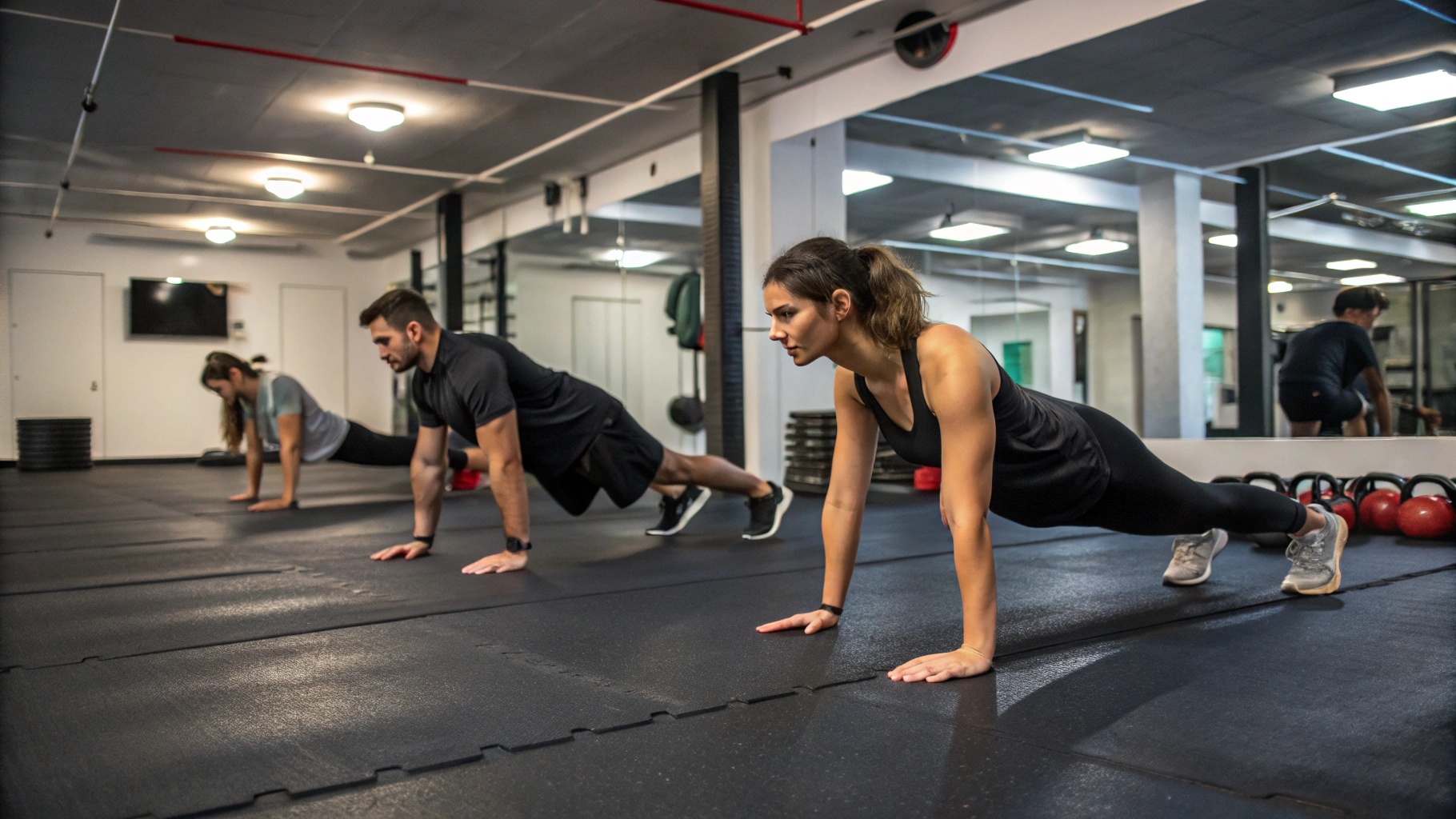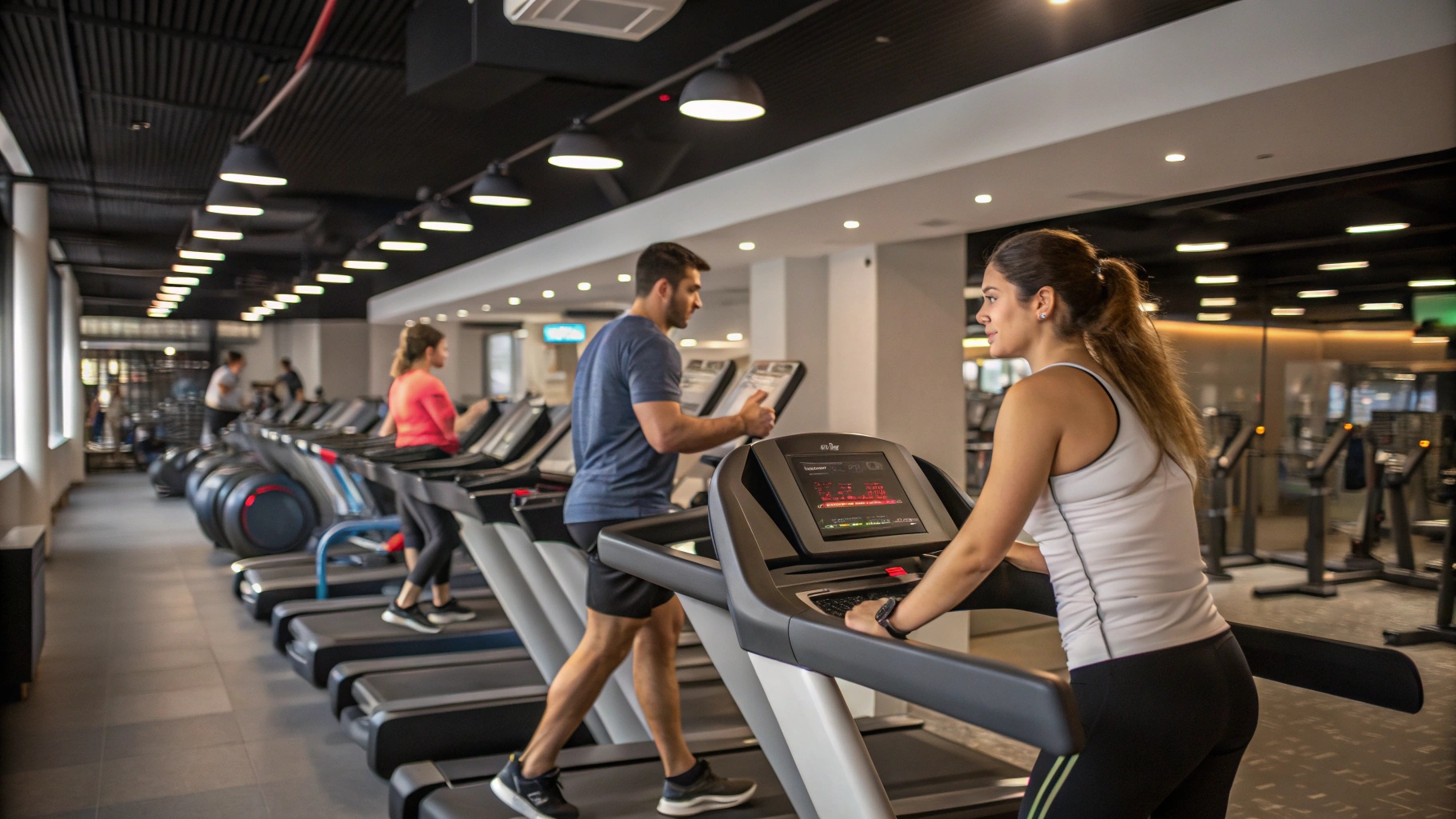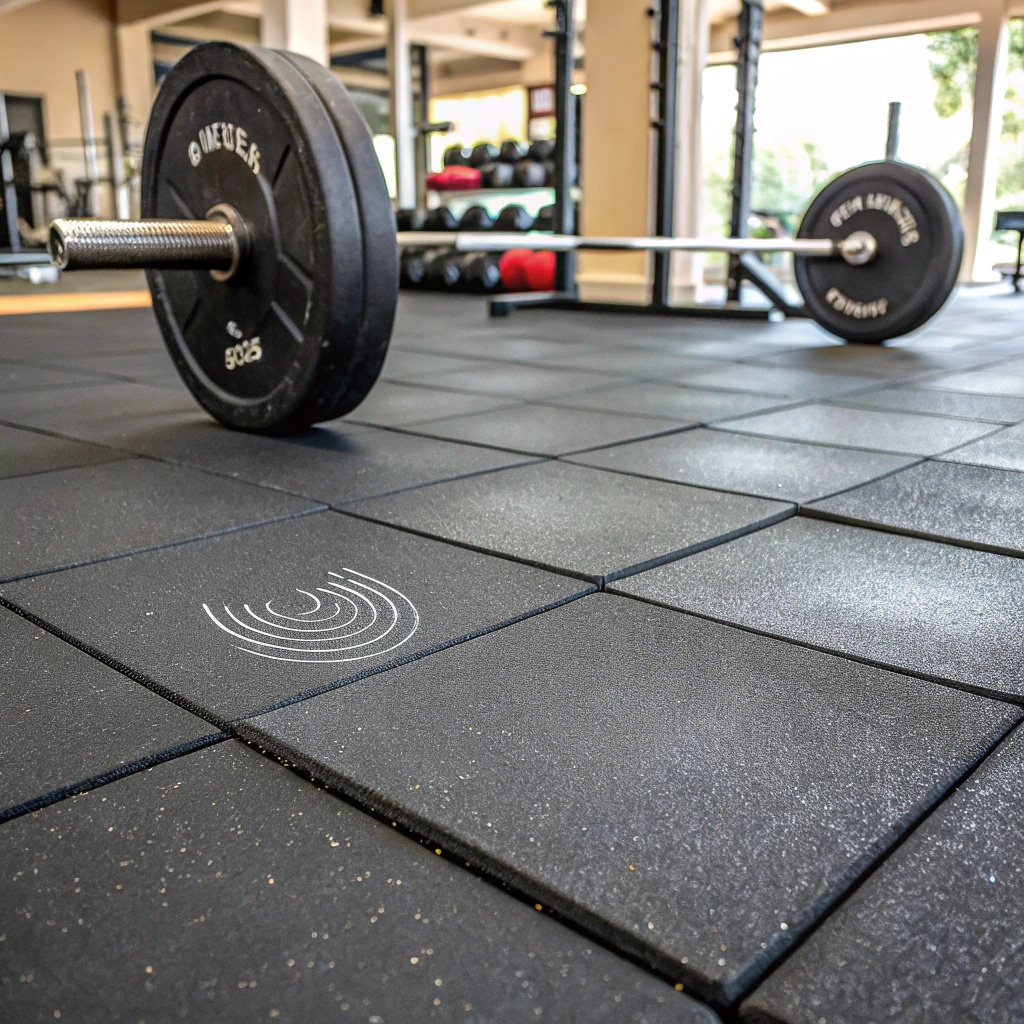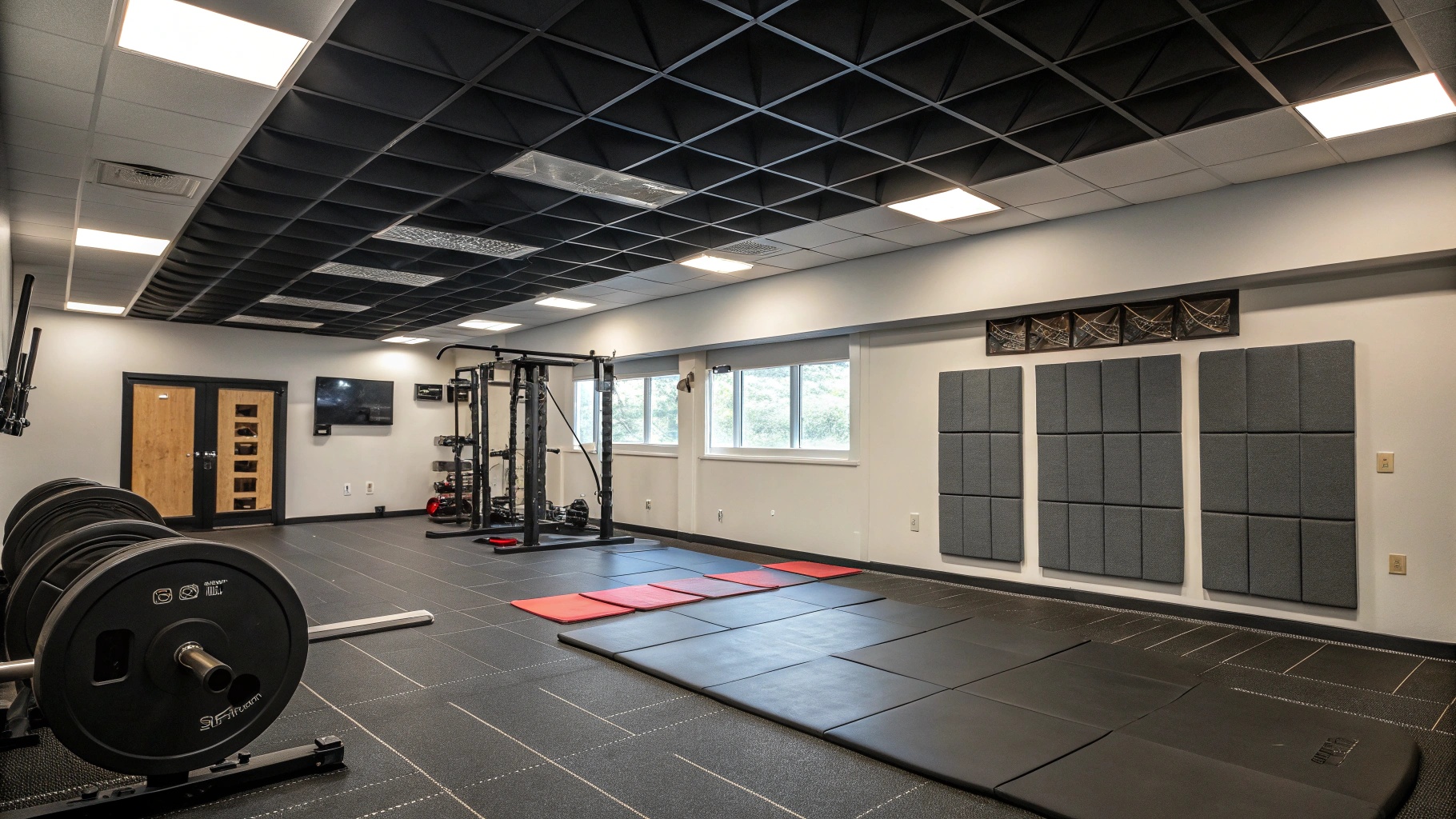Opening a gym is exciting! But, have you ever been in a gym where the constant clanging and banging made you want to run for the exit? Problem solved, right?
The simple answer is, yes, you absolutely can. Choosing the right flooring, like good-quality rubber, and adding smart design features can significantly reduce noise and vibration, making your gym a more pleasant space for everyone. This will keep your clients happy, coming back, and your neighbor
 noise reducing gym flooring
noise reducing gym flooring
Noise and vibration can be a real headache for gym owners. We’re going to break down everything you need to know, from legal stuff to the best flooring, and even how to keep those weights from sounding like a construction zone.
Why Is Noise Reduction Important in a Commercial Gym?
Imagine trying to focus on your workout with weights crashing, treadmills thumping, and music blaring. Annoying, isn’t it? It’s not just irritating – excessive noise1 can be a real problem.
Noise reduction2 is crucial because it keeps your members happy3, protects your neighbors from disturbances, and even helps you avoid legal trouble. It’s a win-win-win situation.
 quiet gym environment
quiet gym environment
How Does Noise Affect Gym Members and Neighbors?
For your members, constant loud noise4 can be distracting, stressful, and even harmful to their hearing over time. Think about that person trying to do yoga in the corner while someone’s dropping heavy weights nearby. Not exactly zen. For your neighbors, especially if you’re in a mixed-use building, the noise from your gym can lead to complaints, conflicts, and even legal action. Like that time i used non-shock obsorbant flooring.
| Impact on Members | Impact on Neighbors |
|---|---|
| Distraction and stress | Complaints and conflicts |
| Reduced workout enjoyment | Potential legal action |
| Potential hearing damage (long-term) | Disruption to their peace and quiet |
| Workout fatigue is increase by 28% | Damage to the building structure (long-term) |
What Are the Legal Requirements for Noise Levels in Gyms?
It’s not just about being a good neighbor – there are often actual laws about how much noise your gym can make. Many cities have noise ordinances5 that set limits on decibel levels6, especially during certain hours. Exceeding 65dB during peak hours risk violating municipal codes7. You’ll need to check your local regulations, but staying compliant keeps you out of trouble and shows you’re a responsible business owner.
What Types of Flooring Are Best for Sound Absorption?
So, you want to quiet things down. The first place to start is the floor. It’s where most of the impact and vibration happens, so choosing the right material is key.
Rubber flooring8 is the gold standard for gyms. It absorbs impact9, dampens vibrations10, and muffles sound, making it a far better choice than hard surfaces like concrete or tile.
 rubber flooring for sound absorption
rubber flooring for sound absorption
How Does Rubber Flooring Help Reduce Noise?
Think of rubber like a shock absorber for your gym. When a weight drops, the rubber compresses and absorbs the energy, preventing it from transferring into the floor and creating a loud bang. It also helps to dampen the vibrations from equipment like treadmills, reducing that annoying thumping sound.
Is Thicker Rubber Always Better for Soundproofing?
It seems obvious, right? Thicker rubber should mean more soundproofing. But it is not the whole story. While thickness does matter, the density of the rubber is just as important. Combining high-density rubber flooring11 (1.5-2.0cm) with shock-absorbing underlayment2s creates a "dual-damping" system. High-density rubber is better at absorbing sound, while a very thick, low-density rubber might not be as effective. Think of it like comparing a thin, dense rubber mat to a thick, fluffy sponge – the mat will do a better job of stopping sound.
Can Underlayments Further Improve Noise Reduction?
Absolutely! Think of an underlayment12 like an extra layer of cushioning beneath your rubber flooring. It’s usually made of foam or a softer type of rubber. This "dual-damping" system works better than just thick rubber alone.It can significantly boost sound absorption, especially for those really heavy impacts, like when someone drops a barbell. This is especially helpful if you have neighbors below you.
What Other Factors Contribute to Gym Noise, and How Can I Address Them?
Flooring is a huge part of the puzzle, but it’s not the only thing to consider. There are other sources of noise in a gym, and some smart strategies can help you tackle them.
Think about weights clanging, treadmills running, and even the echo in the room. All of these contribute to the overall noise level.
 additional noise reduction methods
additional noise reduction methods
How Can I Minimize Noise from Dropped Weights?
This is probably the biggest noise culprit in most gyms. Here’s where dedicated weightlifting platforms13 and thicker rubber mats come in. Platforms are designed to absorb the impact of dropped weights, and they often have multiple layers of shock-absorbing material. They also help protect your subfloor from damage.
Do Treadmills and Other Cardio Equipment Need Special Flooring?
Yes, they do! While the impact isn’t as dramatic as dropped weights, treadmills and other cardio machines still create vibration and noise. Rubber flooring reduces 40% HVAC noise transmission. Placing them on rubber mats, especially those designed for cardio equipment, can make a big difference. You can also look for machines that are designed to be quieter.
Can Wall and Ceiling Treatments Help Reduce Echo and Reverberation?
Absolutely. Think about how sound bounces around in an empty room. Hard surfaces like walls and ceilings reflect sound, creating echo and making the overall noise level seem louder. Adding acoustic panels14, sound-absorbing tiles, or even thick curtains can help absorb sound and reduce that echo effect. It’s like turning down the volume on the room itself.
Conclusion
Reducing noise and vibration in your gym is about creating a better experience for everyone – your members, your neighbors, and even yourself. With the right flooring and a few smart strategies, you can create a gym that’s both energetic and peaceful. Good luck!
-
Learn about the negative impacts of excessive noise on gym environments and member experience. This resource provides valuable information. ↩
-
Understanding the significance of noise reduction can enhance gym member satisfaction and community relations. Explore this link for insights. ↩ ↩
-
Discover how maintaining a quieter environment can lead to happier gym members and better retention rates. This link offers useful strategies. ↩
-
Understanding the impact of constant loud noise can help gym owners create a better environment for members and neighbors alike. ↩
-
Understanding local noise ordinances is crucial for compliance and maintaining good community relations. Explore this link for detailed information. ↩
-
Learn about standard decibel levels to ensure your gym operates within legal limits and avoids penalties. This resource can help you stay informed. ↩
-
Familiarizing yourself with municipal codes can prevent legal issues and enhance your business reputation. Check this link for more insights. ↩
-
Discover why rubber flooring is considered the best choice for gyms, offering superior sound and vibration dampening. ↩
-
Learn how rubber flooring effectively absorbs impact, enhancing safety and comfort in gym settings. ↩
-
Explore various materials that dampen vibrations, ensuring a quieter and more enjoyable workout experience. ↩
-
Explore how high-density rubber flooring can enhance sound absorption and improve your gym’s acoustics. ↩
-
Discover the importance of underlayment in enhancing sound absorption and overall flooring performance. ↩
-
Explore how weightlifting platforms can significantly reduce noise and protect your gym’s flooring. ↩
-
Discover how acoustic panels can enhance sound quality and reduce echo in your gym environment. ↩

](https://www.byfitgear.com/wp-content/uploads/2025/02/Professional-Gym-Flooring-Installation.jpeg)

